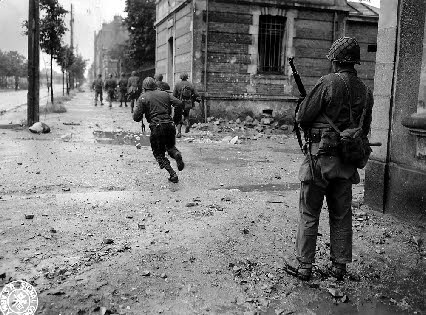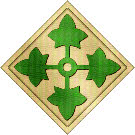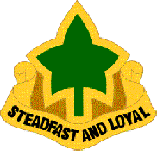

Belgium, Luxembourg, and Germany
The 4th then moved into Belgium through Houffalize to attack the Siegfried Line at Schnee Eifel on 14 September, and made several penetrations. Slow progress into Germany continued in October, and by 6 November the division entered the Battle of Hurtgen Forest, where it was engaged in heavy fighting until early December.
It then shifted to Luxembourg, only to meet the German winter Ardennes Offensive head-on (in the Battle of the Bulge) starting on 16 December 1944. Although its lines were dented, it managed to hold the Germans at Dickweiler and Osweiler, and, counterattacking in January across the Sauer, overran German positions in Fouhren and Vianden.
Halted at the Prüm River in February by heavy enemy resistance, the division finally crossed on 28 February near Olzheim, and raced on across the Kyll on 7 March.
After a short rest, the 4th moved across the Rhine on 29 March at Worms, attacked and secured Würzburg and by 3 April had established a bridgehead across the Main at Ochsenfurt. Speeding southeast across Bavaria, the division had reached Miesbach on the Isar on 2 May 1945, when it was relieved and placed on occupation duty.
World War II Casualties
4,097 Killed in Action
17,371 Wounded in Action
757 Died of Wounds

World War II:
The 4th Infantry Division was reactivated on 1 June 1940 at Fort Benning, Georgia, under the command of MG Walter E. Prosser. 4th ID was reorganized to the Motorized Infantry Division TO&E on 1 August 1940. 4 ID was assigned—along with 2d Armored Division, to the I Armored Corps. 4 ID moved to Dry Prong, Louisiana.
France
The Fourth Division arrived in the UK in early 1944. It took part in the Normandy Invasion landings at Utah Beach, with the 8th Infantry Regiment of the 4th Division being the first surface-borne Allied unit to hit the beaches at Normandy on D-day, 6 June 1944.
Relieving the isolated 82d Airborne Division at Sainte-Mère-Église, the 4th cleared the Cotentin peninsula and took part in the capture of Cherbourg on 25 June. After taking part in the fighting near Periers, 6–12 July, the division broke through the left flank of the German Seventh Army, helped stem the German drive toward Avranches, and by the end of August had moved to Paris, and gave French forces the first place in the liberation of their capital.
During the liberation of Paris in World War II, Ernest Hemingway took on a self-appointed role as a civilian scout in the city of Paris for his friends in the 4 ID. He was with the 22nd Infantry Regiment when it moved from Paris, northeast through Belgium, and into Germany.











